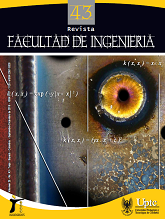Análisis de señales acústicas de pulmón basado en coeficientes cepstrales de la escala Mel y mapas auto-organizados

Resumen
En este trabajo se realizó un análisis de anormalidades en señales acústicas de pulmón. La metodología incluyó el uso de coeficientes cepstrales de la escala Mel (MFCC), Mapas Auto-Organizados (SOM) y el algoritmo de agrupamiento K-means. Los modelos obtenidos con los mapas son conocidos como redes neuronales artificiales, que pueden ser entrenados en una forma supervisada o no supervisada. Ambos tipos de entrenamiento fueron usados para comparar el uso de este tipo de herramientas computacionales en estudios de señales respiratorias. Los resultados mostraron un 85 % de acierto en la clasificación, cuando fue implementado un entrenamiento supervisado. Al realizar tareas de agrupamiento con entrenamiento no supervisado fue encontrado que el número de grupos más adecuado es de tres. En general, los modelos SOM pueden ser usados en este tipo de señales como una estrategia útil en sistemas de diagnóstico, encontrando información en los datos y realizando clasificación para sistemas de apoyo a decisión.Palabras clave
mapas auto-organizados, señales acústicas de pulmón, sistemas de apoyo a decisión
Citas
- A. Alwan, Global status report on non-communicable diseases 2010-2011. World Health Organization, pp.1-176.
- R. Beaglehole, S. Ebrahim, S. Reddy, J. Voute, and S. Leeder, “Prevention of chronic diseases: a call to action,” The Lancet, vol. 370 (9605), pp. 2152-2157, Dec. 2007. DOI: http://dx.doi.org/10.1016/S0140-6736(07)61700-0. DOI: https://doi.org/10.1016/S0140-6736(07)61700-0
- D. T. Jamison et al., Disease Control Priorities in Developing Countries, 2nd. ed., World Bank Publications, 2006. DOI: https://doi.org/10.1596/978-0-8213-6179-5
- A. R. Sovijrvi et al., “Characteristics of breath sounds and adventitious respiratory sounds,” European Respiratory Review, vol.10 (77), pp. 591-596, 2000.
- H. J. Schreur et al., “Abnormal Lung Sounds in Patients with Asthma Function During Episodes with Normal Lung Function,” Chest, vol. 106 (1), pp. 91-99, Jul. 1994. DOI: http://dx.doi.org/10.1378/chest.106.1.91. DOI: https://doi.org/10.1378/chest.106.1.91
- A. Belle, M. A. Kon, and K. Najarian, “Biomedical Informatics for Computer-Aided Decision Support Systems: A Survey,” The Scientific World Journal, vol. 2013, pp. 1-8, 2013. DOI: http://dx.doi.org/10.1155/2013/769639. DOI: https://doi.org/10.1155/2013/769639
- D. S. Kumar, G. Sathyadevi, and S. Sivanesh, “Decision Support System for Medical Diagnosis Using Data Mining,” International Journal of Computer Science Issues, vol. 8 (3), pp.147-153, 2011.
- S. Haykin, Neural Networks and Learning Machines, 3rd ed., Pearson Prentice Hall, 2008.
- O. Er, T. Termutas and A. C. Tanrikulu, “Tuberculosis Disease Diagnosis Using Artificial Neural Networks,” Journal of Medical Systems, vol. 34 (3), pp. 299-302, Jun. 2010. DOI: http://dx.doi.org/10.1007/s10916-008-9241-x. DOI: https://doi.org/10.1007/s10916-008-9241-x
- E. Elveren and N. Yumusak, “Tuberculosis Disease Diagnosis Using Artificial Neural Network Trained with Genetic Algorithm,” Journal of Medical Systems, vol. 35 (3), pp. 329-332, Jun. 2011. DOI: http://dx.doi.org/10.1007/s10916-009-9369-3. DOI: https://doi.org/10.1007/s10916-009-9369-3
- A. D. Santos et al., “Neural networks: an application for predicting smear negative pulmonary tuberculosis,” Advances in statistical methods for the health sciences, pp. 275-287, 2006. DOI: https://doi.org/10.1007/978-0-8176-4542-7_18
- P. Mayorga et al., “Acoustics Based Assessment of Respiratory Diseases using GMM Classification,” in 2010 Annual International Conference of the IEEE Engineering in Medicine and Biology, pp. 6312-6316, Aug. 2010. DOI: http://dx.doi.org/10.1109/iembs.2010.5628092. DOI: https://doi.org/10.1109/IEMBS.2010.5628092
- A. Abushakra and M. Faezipour, “Acoustic Signal Classification of Breathing Movements to Virtually Aid Breath Regulation,” IEEE Journal of Biomedical and Health Informatics, vol. 17 (2), pp. 493-500, Mar. 2013. DOI: http://dx.doi.org/10.1109/JBHI.2013.2244901. DOI: https://doi.org/10.1109/JBHI.2013.2244901
- P. Mayorga et al., “Expanded Quantitative Models for Assessment of Respiratory Diseases and Monitoring,” in 2011 Pan American Health Care Exchanges, pp. 317-322, 2011. DOI: http://dx.doi.org/10.1109/pahce.2011.5871917. DOI: https://doi.org/10.1109/PAHCE.2011.5871917
- A. Banik, R. S. Anand, and M. A. Ansari, “Remote monitoring and analysis of human lung sound,” in 2008 IEEE Region 10 and the Third International Conference on Industrial and Information Systems, pp 1-6, 2008. DOI: http://dx.doi.org/10.1109/iciinfs.2008.4798463. DOI: https://doi.org/10.1109/ICIINFS.2008.4798463
- A. Gurung et al., “Computerized lung sound analysis as diagnostic aid for the detection of abnormal lung sounds: A systematic review and meta-analysis,” Respiratory Medicine, vol. 105 (9), pp. 1396-1403, Sep. 2011. DOI: http://dx.doi.org/10.1016/j.rmed.2011.05.007. DOI: https://doi.org/10.1016/j.rmed.2011.05.007
- Database RALE Univeristy of Manitoba, Canada. http://www.rale.ca/
- G. Charbonneau et al., “Basic techniques for respiratory sound analysis,” European Respiratory Review. vol. 10 (77), pp. 625-635, 2000.
- L. Rabiner and J. Biing-Hwang, Fundamentals of Speech Recognition, Prentice Hall, 1993.
- T. Kohonen, Self-Organizing Maps, Springer, 2000. DOI: https://doi.org/10.1007/978-3-642-56927-2
- L. Faussete, Fundamentals of Neural networks: architectures, algorithms, and applications. 3rd ed., Prentice Hall, 1994.
- R. Kohavi, “A study of cross-validation and bootstrap for accuracy estimation and model selection,” in Proceedings of the 14th International Joint Conference on Artificial Intelligence, pp. 1137-1143, Feb. 1995.
- A. Zoubir and R. Iskander, Bootstrap Techniques for Signal Processing. Cambridge: Cambridge University Press, 2004. DOI: http://dx.doi.org/10.1017/CBO9780511536717. DOI: https://doi.org/10.1017/CBO9780511536717
- A. Elisseeff, “Leave-one-out error and stability of learning algorithms with applications,” NATO Science Series Sub Series III Computer and Systems Sciences, vol. 190, pp. 111-130, 2003.
- T. Kanungo et al., “An Efficient k-Means Clustering Algorithm: Analysis and Implementation,” IEEE Trans. Pattern Anal. Mach. Intell., vol. 24 (7), pp. 881-892, Jul. 2002. DOI: http://dx.doi.org/10.1109/TPAMI.2002.1017616. DOI: https://doi.org/10.1109/TPAMI.2002.1017616
- D. L. Davies and D. W. Bouldin. “A cluster separation measure,” IEEE Trans. Pattern Anal. Mach. Intell., vol. PAMI-1 (4), pp. 224-227, Apr. 1979. DOI: http://dx.doi.org/10.1109/TPAMI.1979.4766909. DOI: https://doi.org/10.1109/TPAMI.1979.4766909
- P.J. Rousseeuw, “Silhouettes: a graphical aid to the interpretation and validation of cluster analysis,” J. Computational Appl. Math., vol. 20, pp. 53-65, 1987. DOI: http://dx.doi.org/10.1016/0377-0427(87)90125-7. DOI: https://doi.org/10.1016/0377-0427(87)90125-7
- A.D. Orjuela-Cañón and D.F. Gómez-Cajas, “Artificial Neural Networks for Acoustic Lung Signal Classification,” Lecture Notes in Computer Sciences, vol. 8827, pp. 214-221, 2014. DOI: http://dx.doi.org/10.1007/978-3-319-12568-8_27. DOI: https://doi.org/10.1007/978-3-319-12568-8_27
Descargas
Los datos de descargas todavía no están disponibles.